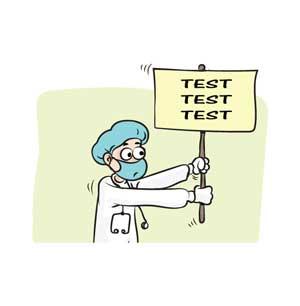17 Nov 2020 - {{hitsCtrl.values.hits}}
 Colombo’s Chief Medical Officer of Health Dr. Ruwan Wijemuni, after conducting a series of random PCR tests in the Colombo City, had said days ago that there may be more than 30,000 people infected with COVID-19 in the City of Colombo. Dr. Wijemuni told media that around 300 people in the city had been randomly selected for a PCR test and that five percent of them had tested positive. Since there are about 600,000 people in Colombo, he opined that more than 30,000 people in the city were suspected to have been infected.
Colombo’s Chief Medical Officer of Health Dr. Ruwan Wijemuni, after conducting a series of random PCR tests in the Colombo City, had said days ago that there may be more than 30,000 people infected with COVID-19 in the City of Colombo. Dr. Wijemuni told media that around 300 people in the city had been randomly selected for a PCR test and that five percent of them had tested positive. Since there are about 600,000 people in Colombo, he opined that more than 30,000 people in the city were suspected to have been infected.
He said that 80 percent of the infected people did not show any symptoms but they were carriers of the disease. When the COVID-19 cluster within the navy was the main concern among the authorities involved in the combating of the pandemic in April/May, Defence Secretary retired Major General Kamal Gunarathna also said that 72 percent of the infected sailors had been asymptomatic.
Dr. Wijemuni’s numbers have not been contested by anybody within the health sector, despite what the outcome of the tests he had conducted being extremely serious. Dr. Jayaruwan Bandara, the former spokesman for the Health Ministry too had shared the view before he was removed from the post of spokesman . It is startling even to imagine that there are more than 30,000 infections within the Colombo city limits when the whole country’s official figures stands just at 16,000.
The Government Medical Officers Association (GMOA) which has been stressing the need to conduct random PCR tests among various groups among the society since the beginning of the COVID-19 outbreak in Sri Lanka, also warned about an alarming outbreak of the deadly virus among the people living in Colombo. Apparently pointing out the same random tests conducted among the people in the capital city, GMOA Editor Dr. Haritha Aluthge said that 19 out of 400 random PCR tests conducted in the Colombo Municipality area had shown “positive” results. He warned that if the authorities did not take correct steps they would have to talk more about deaths than infected people in the month of December.
The presumption by Dr. Wijemuni or Dr.Aluthge on the basis of these tests may not be correct or exact. The situation may be different than the presumption. But nobody can reject it.
These tests had not been conducted on the contact persons of already infected persons or suspected persons, according to Dr. Aluthge. He said these were not people from high risk groups but people randomly selected from those just moving around. “Clusters are spontaneously found as random sampling is not properly taken in the community. If random sampling had been proceeded as a country, the Minuwangoda cluster would not have reached thousands by now,” he had said. In fact, had there been a programme to conduct random tests within workplaces where thousands of men and women were employed, the Brandix and the Peliyagoda clusters sometimes could have been detected at the initial stage with only few positive cases. The authorities had to wake up only after the contact persons of the two clusters had taken the deadly virus to all 25 districts.
The results of the random tests conducted within the Colombo Municipality area alone suffice to accept that Sri Lanka has entered the community spread stage of COVID-19, even according to the World Health Organisation (WHO) criterion. Finding the past trajectory of the virus up-to an individual case or a cluster is important, but it is not a fact to be satisfied as it is more important to detect its future trajectory which is extremely difficult.
WHO Director General Tedros Adhanom Ghebreyesus had sent a simple message to the world in respect of minimising the Coronavirus threat as early as March 16, this year, five days after Sri Lanka found its first local COVID-19 case, in just three words- “Test, Test, Test.” Needless to say that Sri Lanka cannot even dream of launching testing programmes similar to those conducted in China in June and October, in the cities of Wuhan and Qingdao. In Wuhan the entire population of 11 million people was subjected to tests within ten days and in Qingdao the number was nine million. Yet, the message is clear. We have to strive to increase the number of tests among randomly selected groups as well as suspected groups without which there wouldn’t be a way out.
30 Nov 2024 3 hours ago
30 Nov 2024 4 hours ago
30 Nov 2024 6 hours ago
30 Nov 2024 9 hours ago
30 Nov 2024 30 Nov 2024